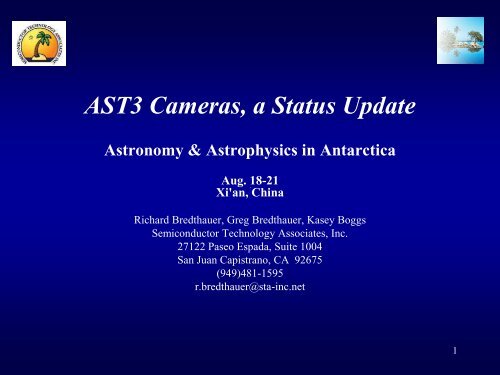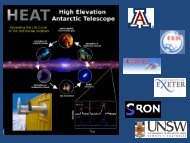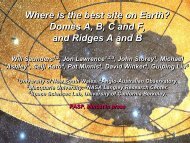AST3 Cameras, a Status Update
AST3 Cameras, a Status Update
AST3 Cameras, a Status Update
Create successful ePaper yourself
Turn your PDF publications into a flip-book with our unique Google optimized e-Paper software.
<strong>AST3</strong> <strong>Cameras</strong>, a <strong>Status</strong> <strong>Update</strong><br />
Astronomy & Astrophysics in Antarctica<br />
Aug. 18-21<br />
Xi'an, China<br />
Richard Bredthauer, Greg Bredthauer, Kasey Boggs<br />
Semiconductor Technology Associates, Inc.<br />
27122 Paseo Espada, Suite 1004<br />
San Juan Capistrano, CA 92675<br />
(949)481-1595<br />
r.bredthauer@sta-inc.net<br />
1
Introduction<br />
• Semiconductor Technology Associates provides the<br />
imaging industry with custom charge-coupled device<br />
design, fabrication, characterization and operation<br />
• <strong>Update</strong> of our current work on a CCD camera system for<br />
the <strong>AST3</strong> telescopes.<br />
• Description of recently developed CCD devices of<br />
interest for the astronomical community.<br />
2
Antarctica Schmidt Telescopes<br />
(<strong>AST3</strong>)<br />
• Location Dome: A Antarctica<br />
• Clear aperture: 50cm<br />
• FOV: 4.2°<br />
• Wave Band: 400nm-900nm<br />
(g, r, i filters for 3 telescopes )<br />
• Scale:1 arcsec/pixel<br />
• Image quality: 80% energy encircled in one pixel<br />
• Type: STA1600-FT Charge Coupled Device<br />
• Working mode: frame transfer<br />
3
<strong>AST3</strong> Camera Assembly<br />
• Camera assembly mounted<br />
within tube for fine focusing.<br />
4
<strong>AST3</strong> Dewar Housing<br />
• 180mm diameter stainless<br />
steel dewar<br />
• TE Cooling for operation<br />
at -80C<br />
– Average outdoor<br />
temperature -50C<br />
5
<strong>AST3</strong> Dewar System<br />
• STATUS: Dewar<br />
– Three housings have been completed<br />
– Presently undergoing cold testing<br />
6
STA1600 111Mega pixel imager<br />
• Full 6” wafer imager<br />
• Image area 95 mm x 95 mm<br />
• 10560 x 10560 pixels<br />
• 9 micron pixel<br />
• 111,513,600 pixels per frame<br />
• Backside thinned for high QE<br />
• Acquisition speeds up to 1 frame/sec<br />
• Originally designed for US Naval<br />
Observatory - Astrometry<br />
7
STA1600-FT Performance<br />
• Image area 95 mm x 47.5 mm<br />
• 16 dual stage high speed outputs<br />
• 7.0-9.0 electrons noise @ 1.0<br />
MHz<br />
• 5.0 electrons @ 100 kHz<br />
• Full well > 80,000 electrons<br />
non-MPP<br />
8
STA1600-FT CCD<br />
• Modified for split frame transfer<br />
operation<br />
• Additional metal strapping achieves<br />
frame transfer rate of 100 Khz<br />
• Design modifications expressly for<br />
<strong>AST3</strong> operation<br />
• STATUS: STA1600-FT CCD<br />
– CCD fabrication run completed<br />
– CCDs out to be thinned this month<br />
STA1600-FT Frame Transfer Imager<br />
9
QE (%)<br />
Typical Backside QE<br />
100%<br />
STA1600_131716W18_URAT#01<br />
1MHz @ -80C<br />
90%<br />
80%<br />
70%<br />
60%<br />
50%<br />
40%<br />
30%<br />
20%<br />
10%<br />
0%<br />
300 400 500 600 700 800 900 1000<br />
Wavelength (Nanometers)<br />
• Coating optimized for broadband response<br />
• Measured QE for 30 micron silicon epitaxial layer<br />
10
STA1600 Performance<br />
Photon Transfer Curve<br />
Charge Transfer Efficiency<br />
• HCTE and VCTE > 0.999998<br />
• Less than 1% non-linearity between 200 e-<br />
and 80ke-<br />
11
STA1600 Performance Enhancement<br />
• These frontside images exhibit the on chip strapping necessary to<br />
reduce vertical gate time constant.<br />
• As a result the device can be driven at enhanced data rates without<br />
degradation of CTE or increased image smear.<br />
• Allows for high speed parallel transfer from frame store operation<br />
12
Reflex Camera<br />
• Reflex Camera System<br />
– 11” x 9” x 5.5” (6-slot chassis)<br />
• Flexible Modular Features<br />
– 8-ch 100 Mhz 16-bit A-D<br />
– 12-ch 200 Mhz 16-bit clock driver<br />
• +/- 12V (Programmable slew)<br />
– 16-ch 16 bit DC bias<br />
• Voltage and current monitoring<br />
• Programmable current limit<br />
– Full cameralink interface<br />
• Swappable for custom, gigabit<br />
ethernet, firewire.<br />
– Single 12 V DC power supply<br />
Internal board set<br />
13
Reflex Camera<br />
• There is a FPGA programmable<br />
timing core<br />
• Sixteen 16-bit ADC channels each<br />
have low noise fully differential<br />
AC-coupled preamps<br />
• CCD clock drive signals are<br />
generated from 200 Mhz DACs<br />
• STATUS: Three cameras<br />
completed for <strong>AST3</strong><br />
14
STA1600 Themes and Variations<br />
• STA1600<br />
– Standard device with dual stage high speed outputs<br />
– Full frame imager<br />
• STA1600 MPP<br />
– Frontside illuminated low dark current<br />
• STA1600 LN<br />
– 16 single stage low noise outputs.<br />
• STA1600 FT<br />
– Frame transfer operation<br />
• STA1600 DD<br />
– Deep depletion<br />
15
Large Focal Plane Efficiency<br />
4kx4k CCD adjacent to STA1600<br />
• Four 10ks provide more active image area than nine 4k imagers<br />
• 91% Active area for 4k imager<br />
• 95% Active area for 10k imager<br />
16
USNO Robotic Astrometric Telescope<br />
URAT<br />
• 8 inch Refracting Telescope for Astrometry<br />
• Upgrade initiated to a 2x2 array by Dr Norbert<br />
Zacharias for an all sky survey - URAT<br />
• STA is providing complete system including<br />
• Dewar – Window – Bonn Shutter<br />
• Four BI STA1600 CCDs – Three STA 3000 Guiders<br />
• Five Aura cameras with software<br />
• Telescope robotic control software<br />
17
URAT 2x2 Focal Plane<br />
• Next generation astrometry focal plane<br />
– 1 Frame = 1 Gigabyte of data<br />
• Incorporates buttable package version of<br />
STA1600<br />
• GL Scientific Dewar<br />
18
RMS Noise (e-)<br />
STA1600 LN<br />
• Low noise version of STA1600<br />
• 16 dual stage outputs are<br />
replaced with single stage low<br />
noise outputs<br />
• Noise < 3 electrons<br />
• Sensitivity 4-5 µV/e-<br />
• Identical pinout<br />
• Available Fall 2010<br />
6<br />
5.5<br />
5<br />
4.5<br />
4<br />
3.5<br />
3<br />
2.5<br />
2<br />
Measured RMS Noise (e-)<br />
1.5<br />
1<br />
10 100 1000<br />
Readout Rate (kHz)<br />
Measured on backside thinned STA0510<br />
19
STA1600 DD<br />
• Deep depletion for maximum red response<br />
• STA1600DD would have similar performance<br />
• 93 µm thickness<br />
• >50% QE @ 1 µm<br />
• Available 2011<br />
20
STA1920A LSST<br />
• Study contract device<br />
• 100 µm thick, high resistivity bulk<br />
silicon, capable of overdepletion<br />
• 4K x 4K, 10 µm pixels, 16 outputs<br />
Crab Nebula shows chip segmentation<br />
1.2 m Calypso Telescope at Kitt Peak<br />
21
Substrate bias control of<br />
charge diffusion<br />
•<br />
55<br />
Fe xrays generate compact charge<br />
clusters within ~30 µm of silicon<br />
surface.<br />
• Fully depleting the silicon restores<br />
the PSF<br />
partially depleted<br />
fully depleted<br />
Binary star with 0.9” separation<br />
22
Summary<br />
• The <strong>AST3</strong> camera system is making very good progress<br />
• The STA1600-FT CCDs have been fabricated and are out for backside<br />
thinning<br />
• The <strong>AST3</strong> dewars are complete and undergoing cold testing.<br />
• The <strong>AST3</strong> Camera electronics are complete.<br />
• Thank you for your attention.<br />
23






